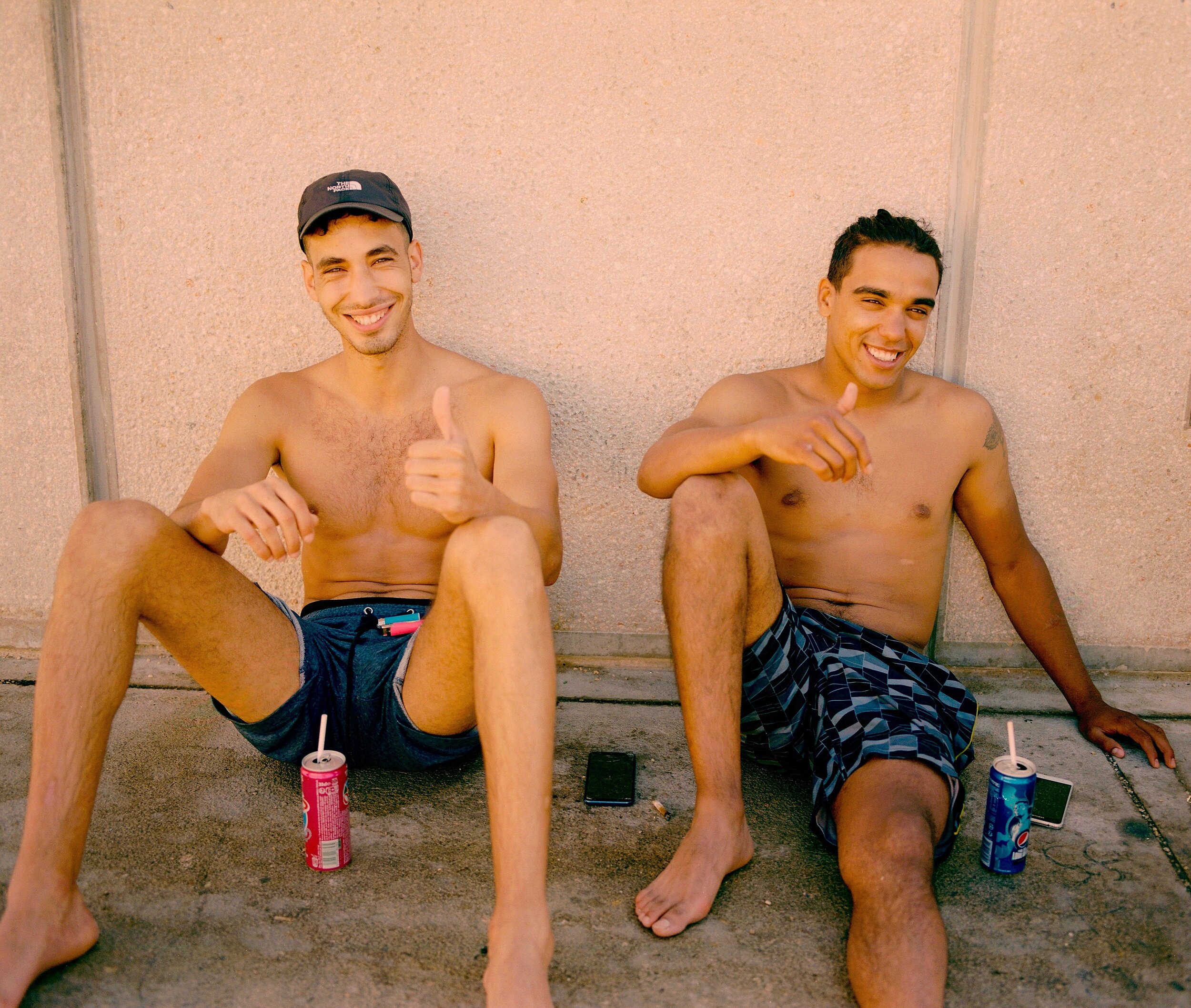
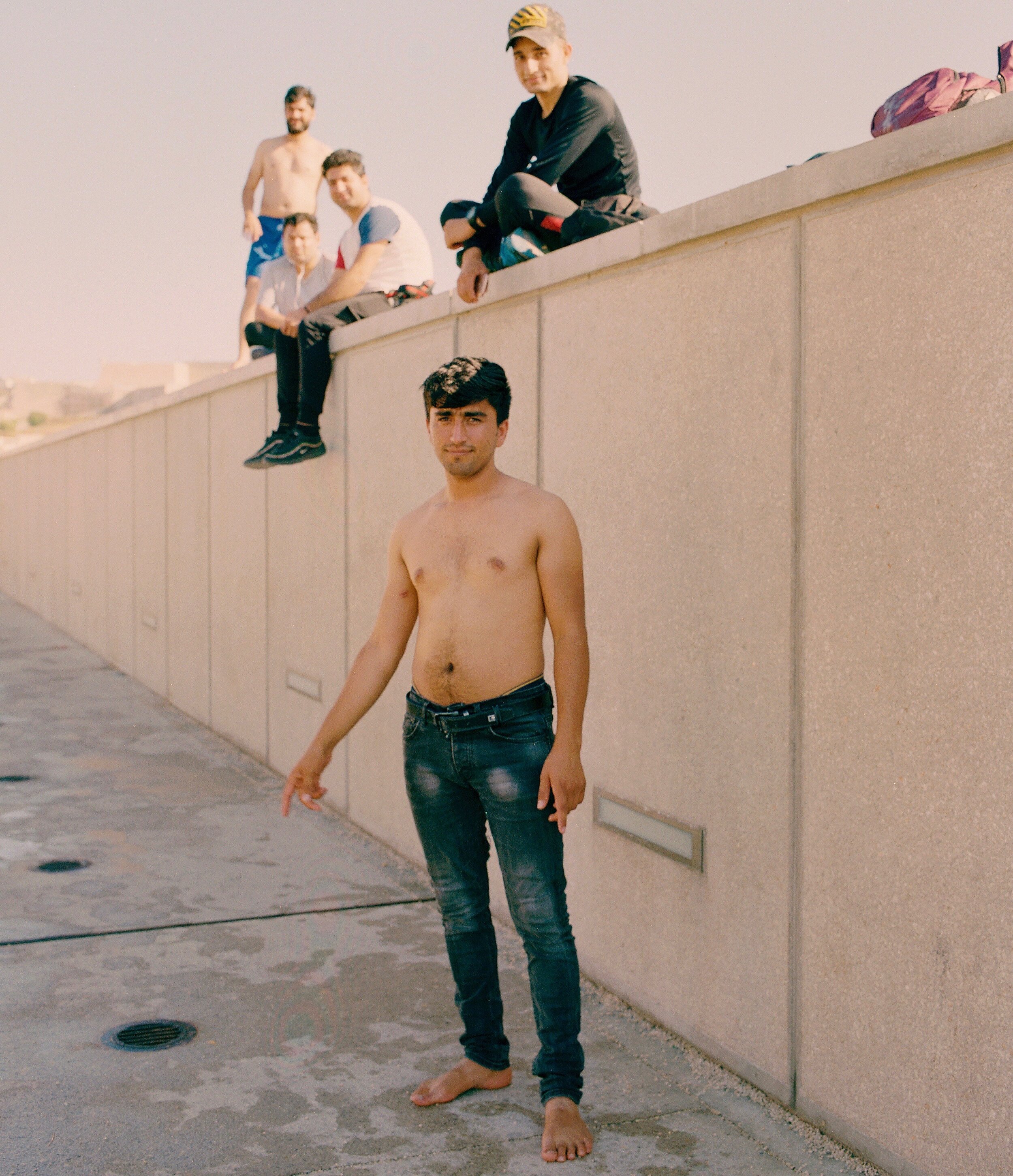
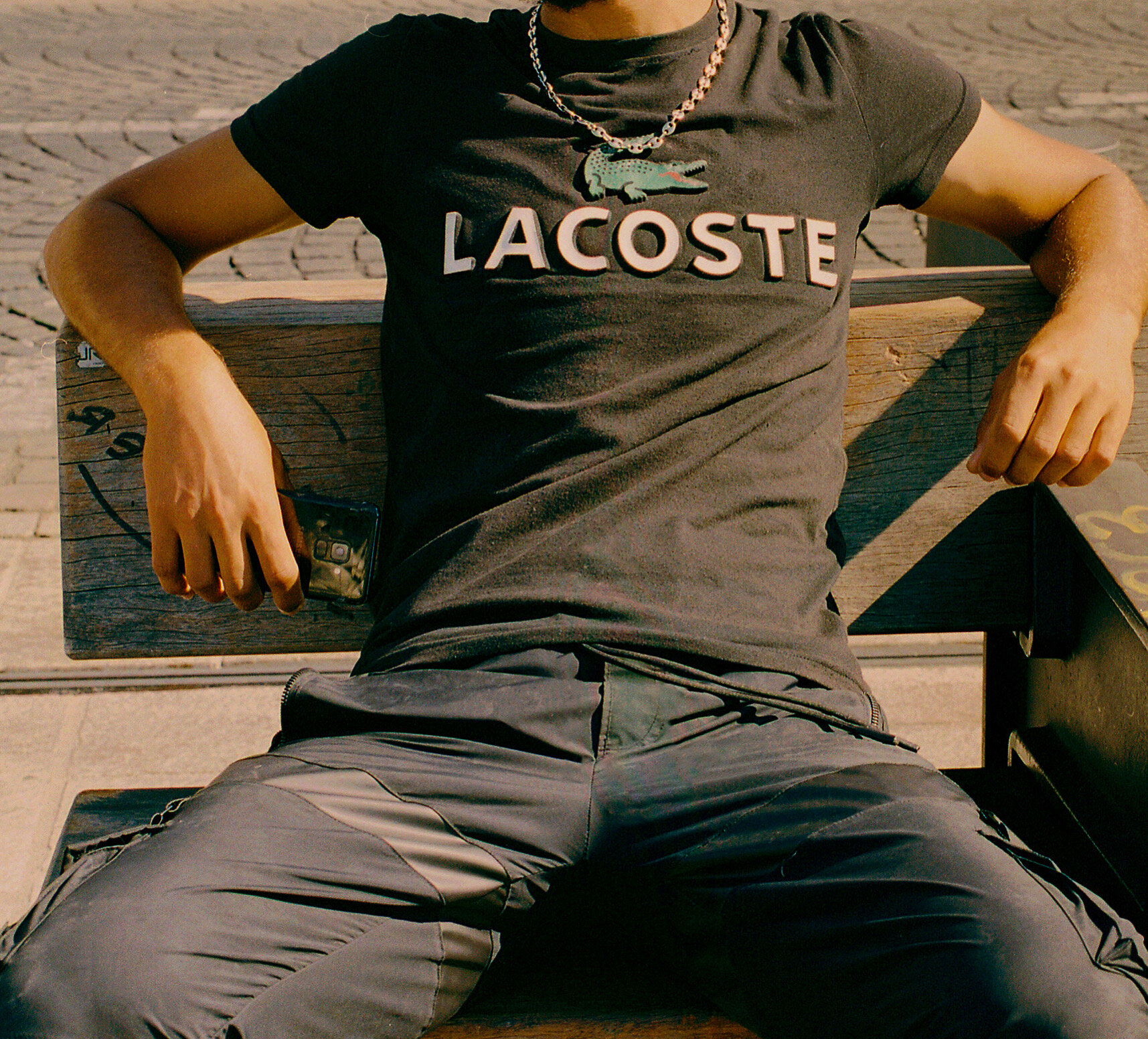

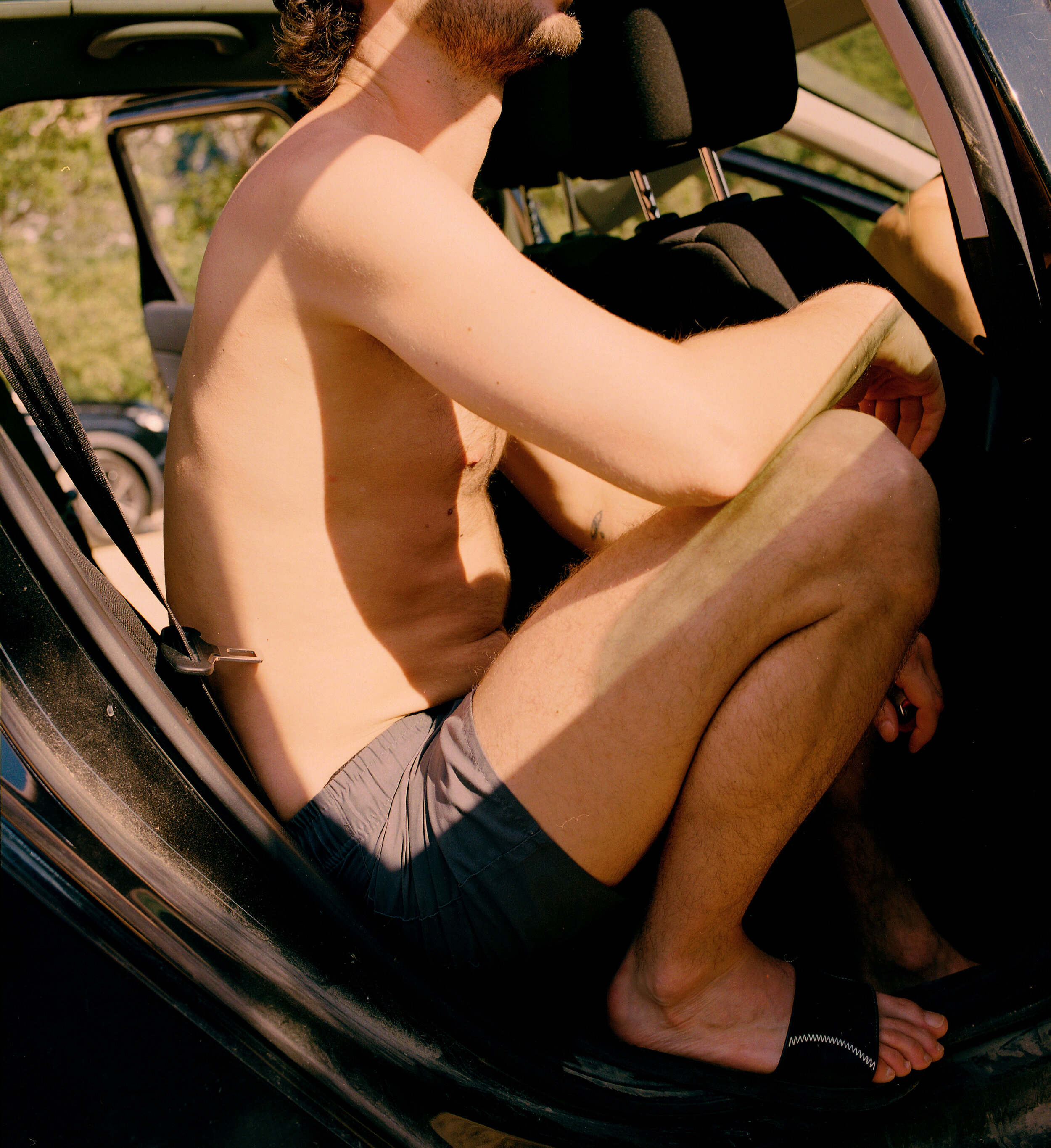
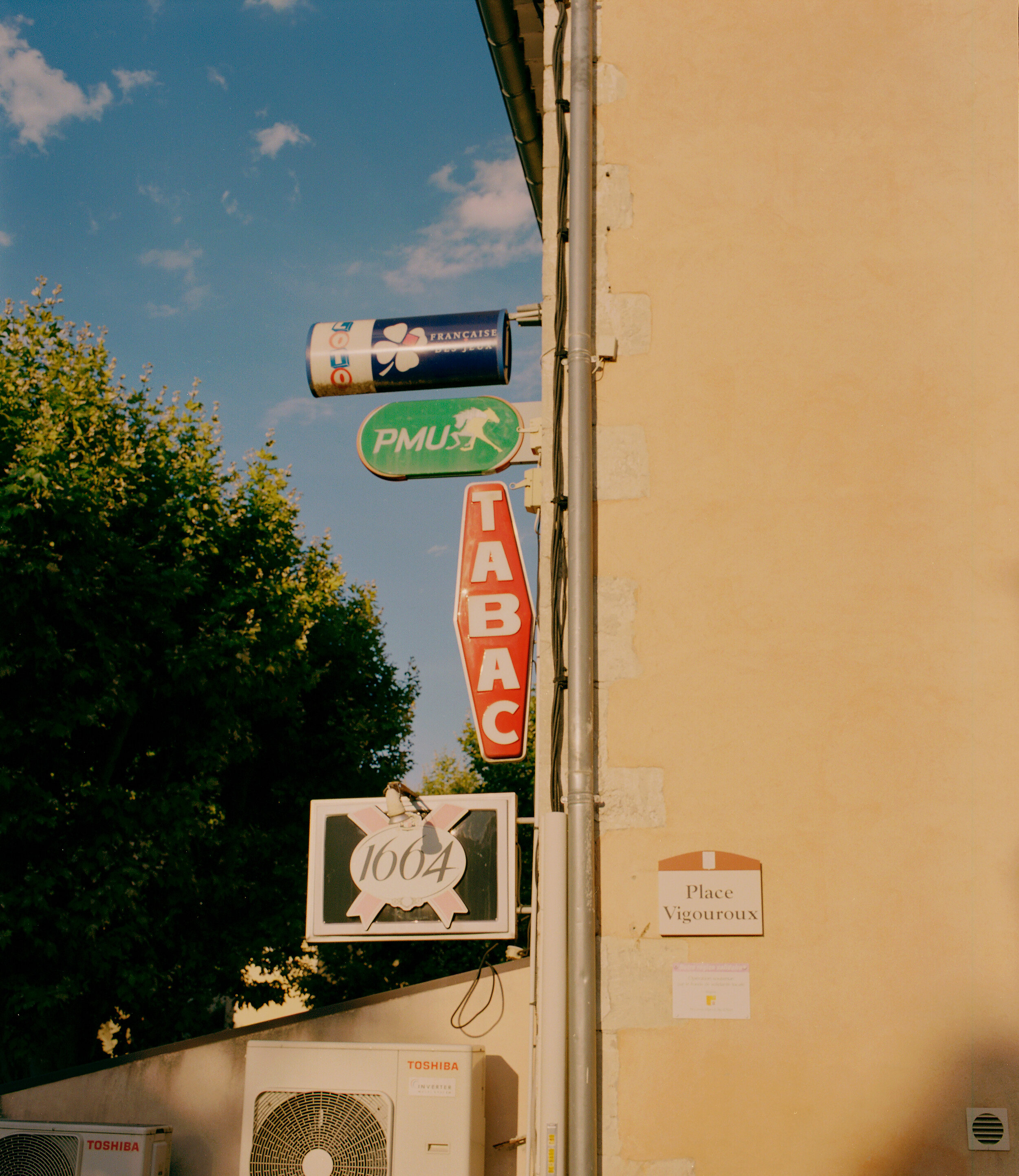
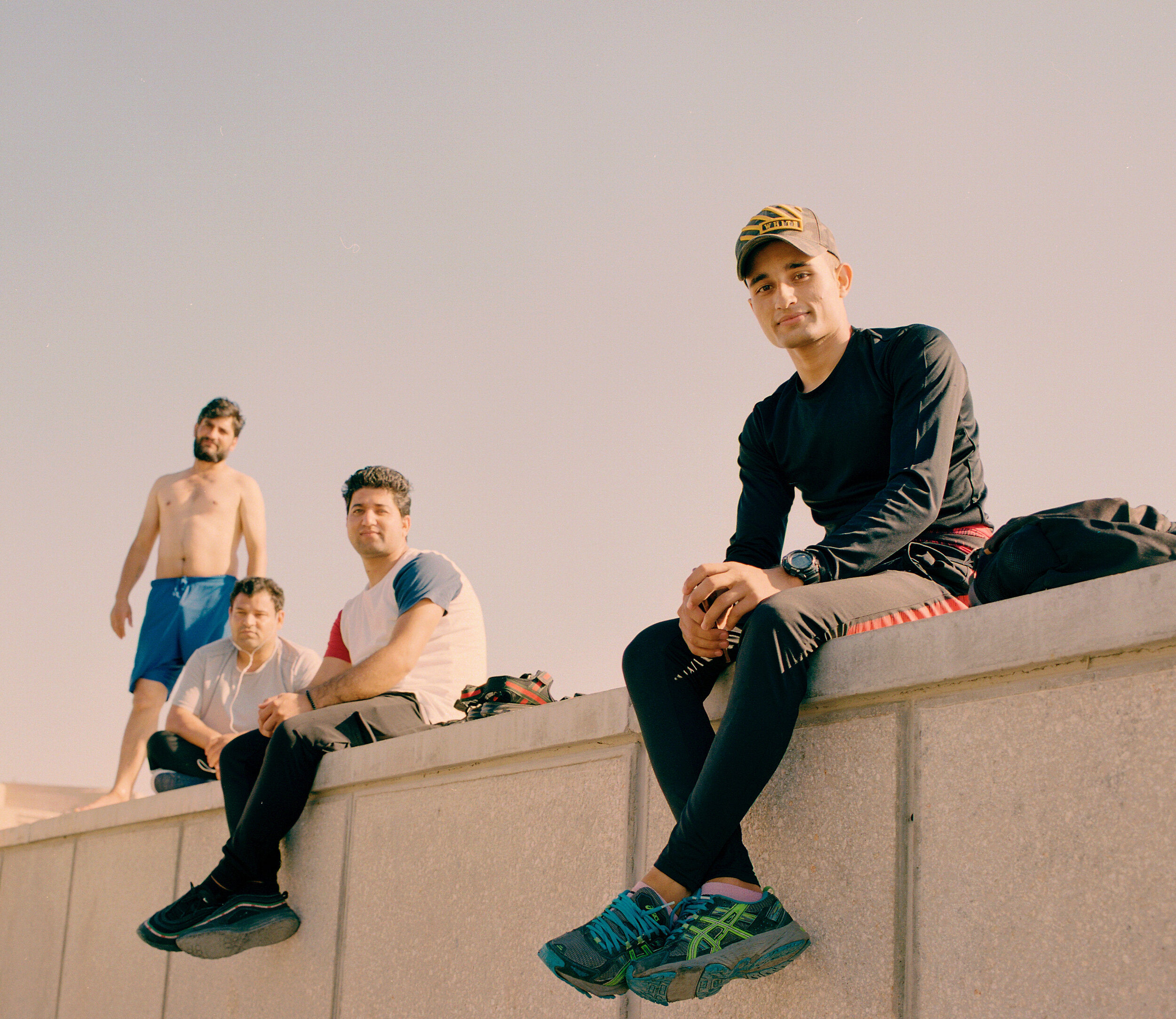

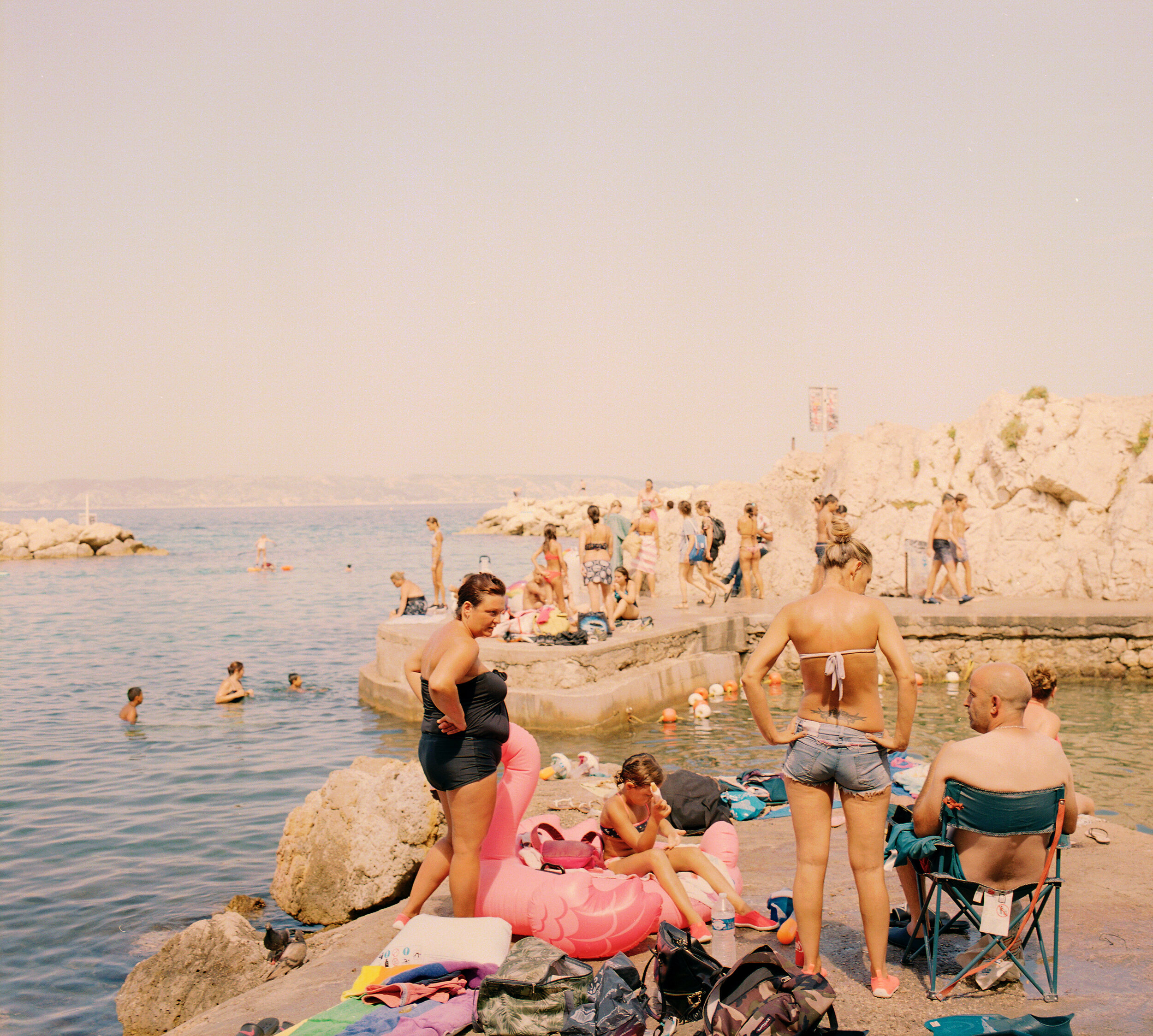


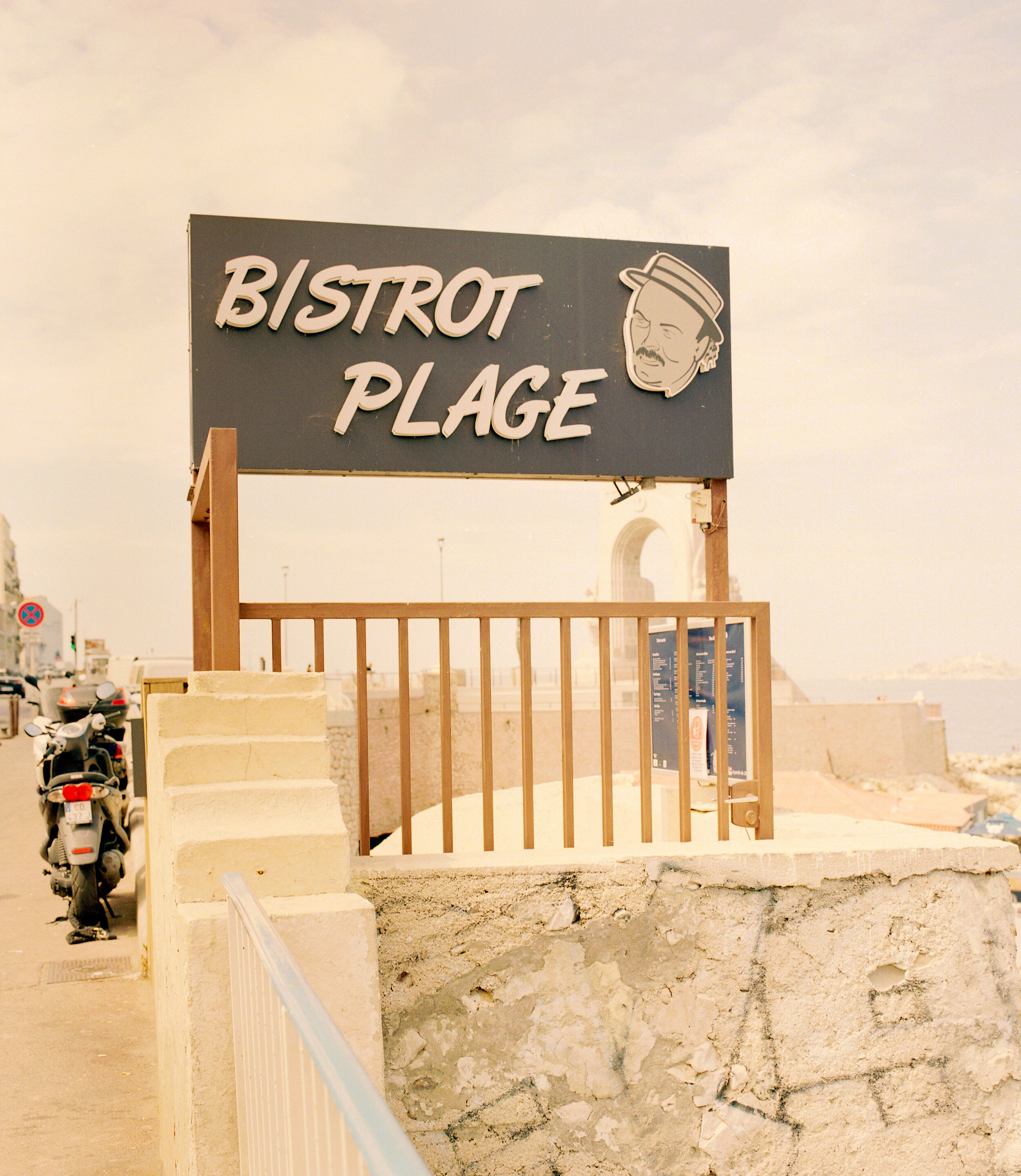
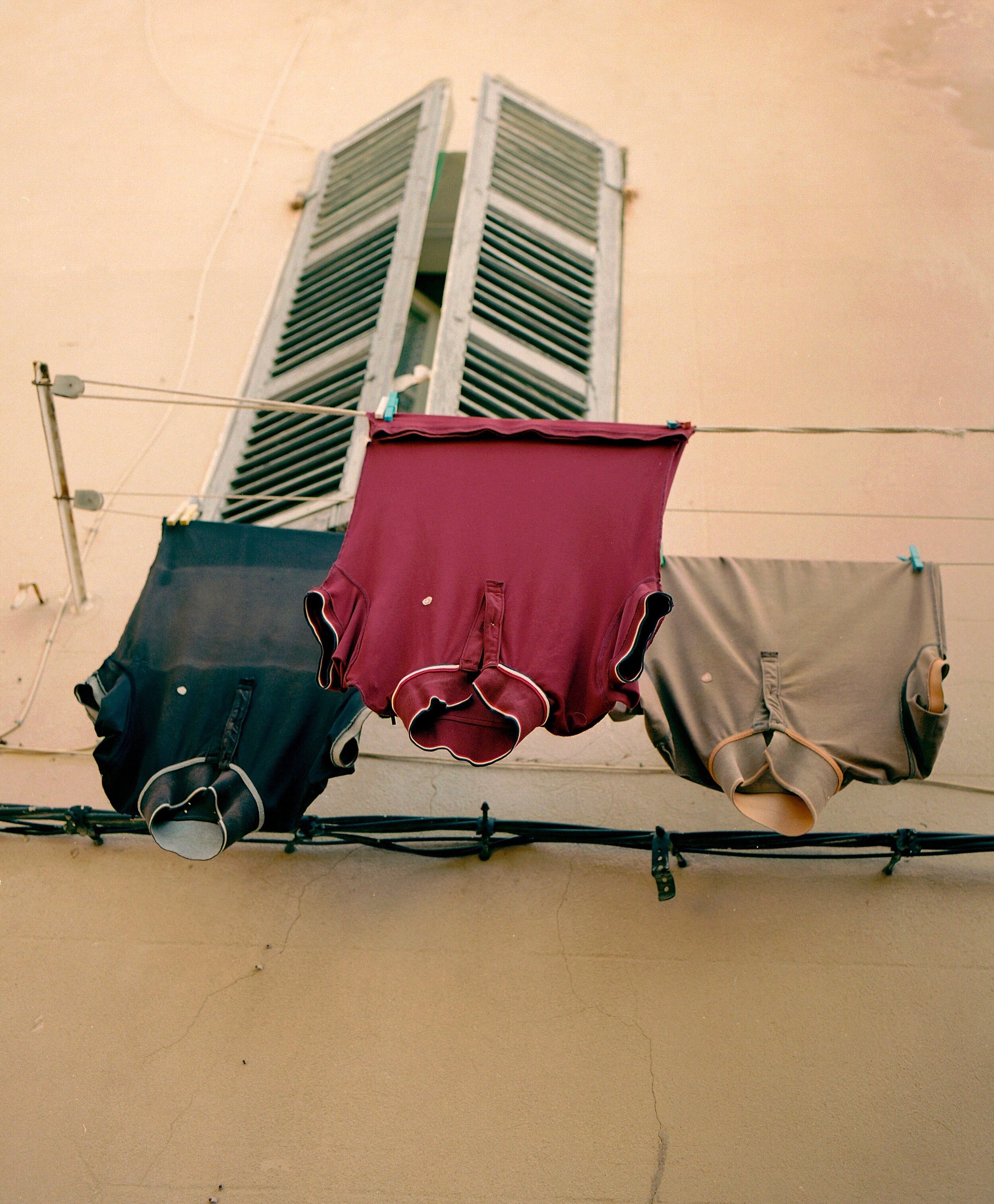

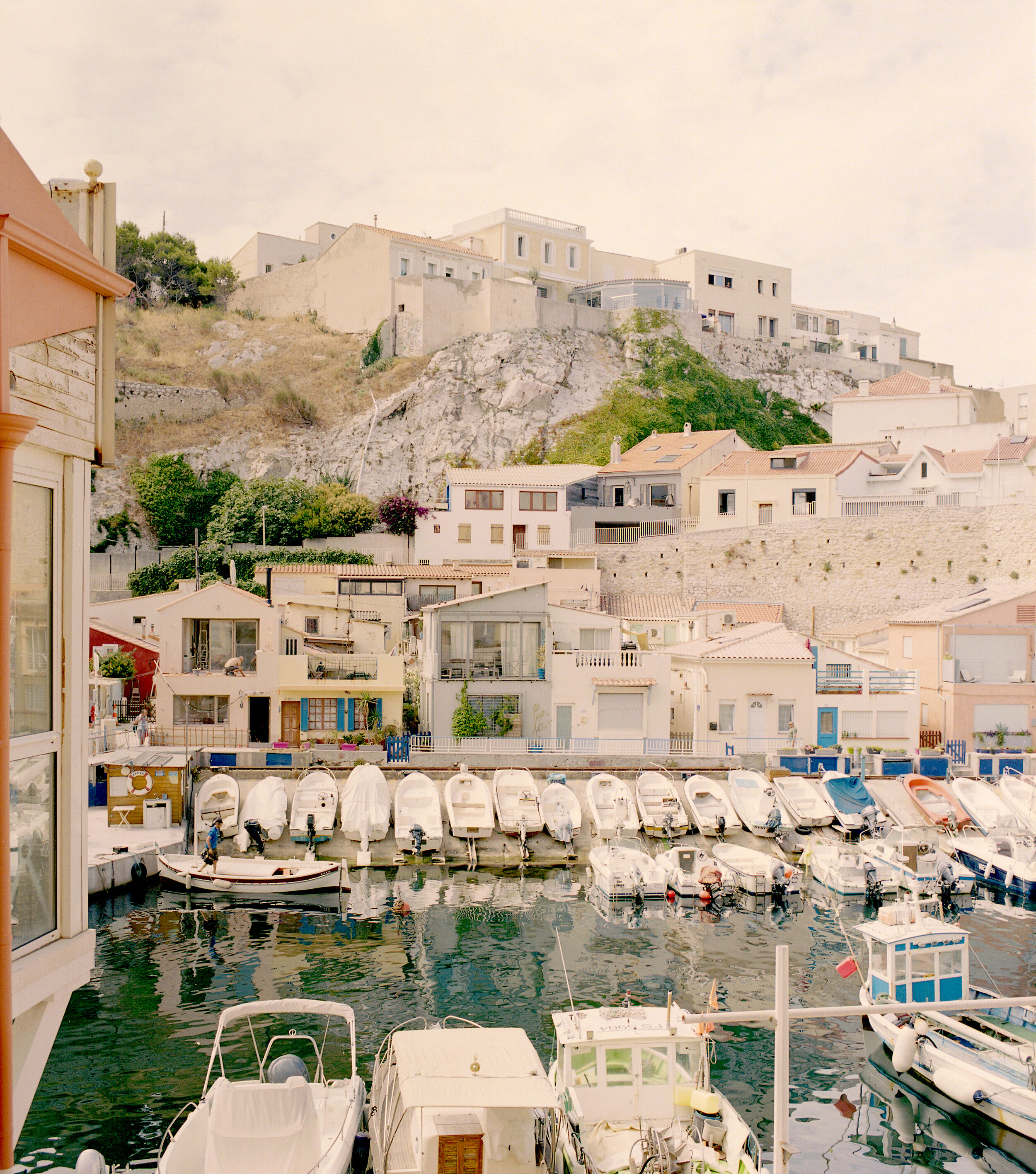
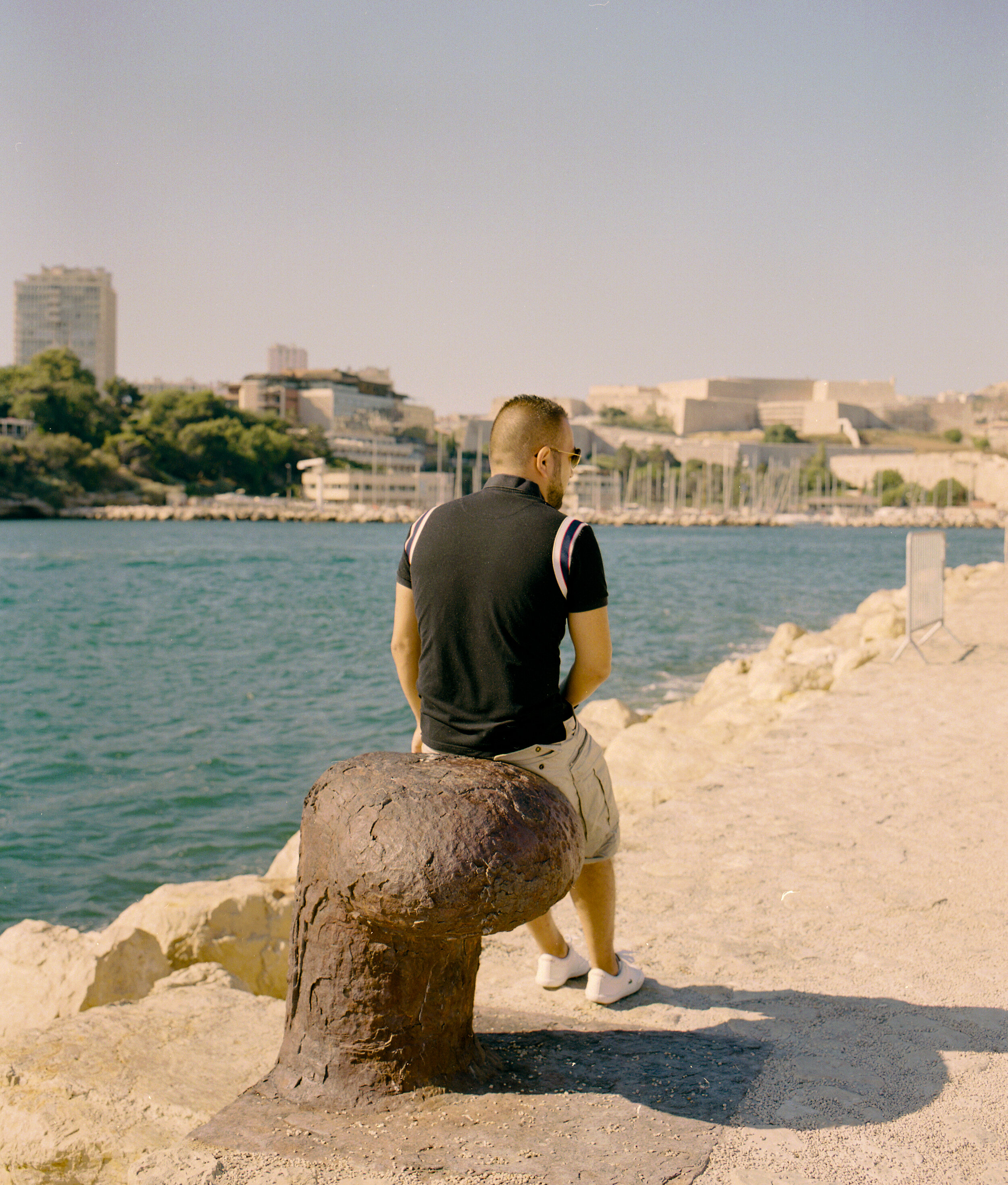
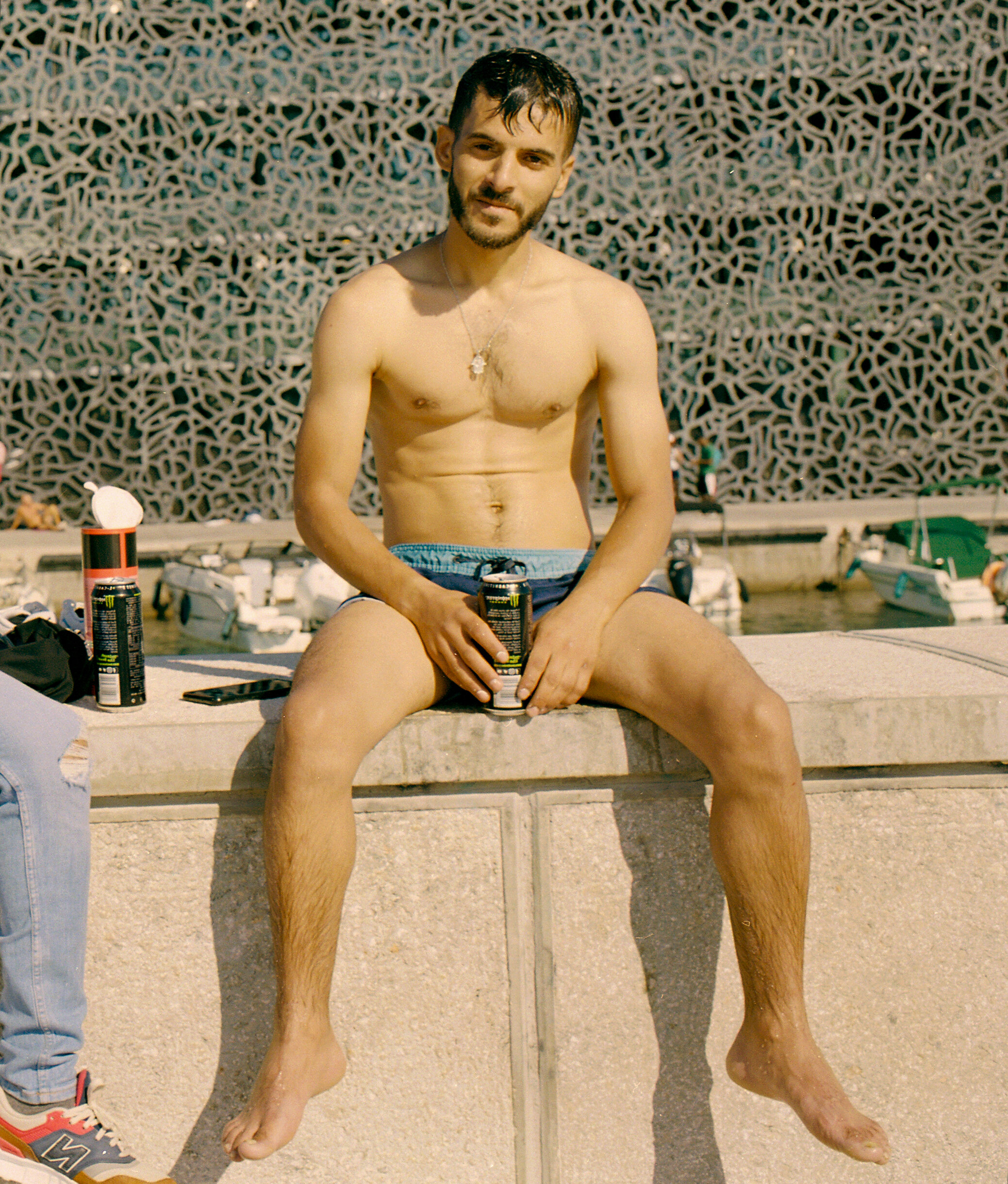

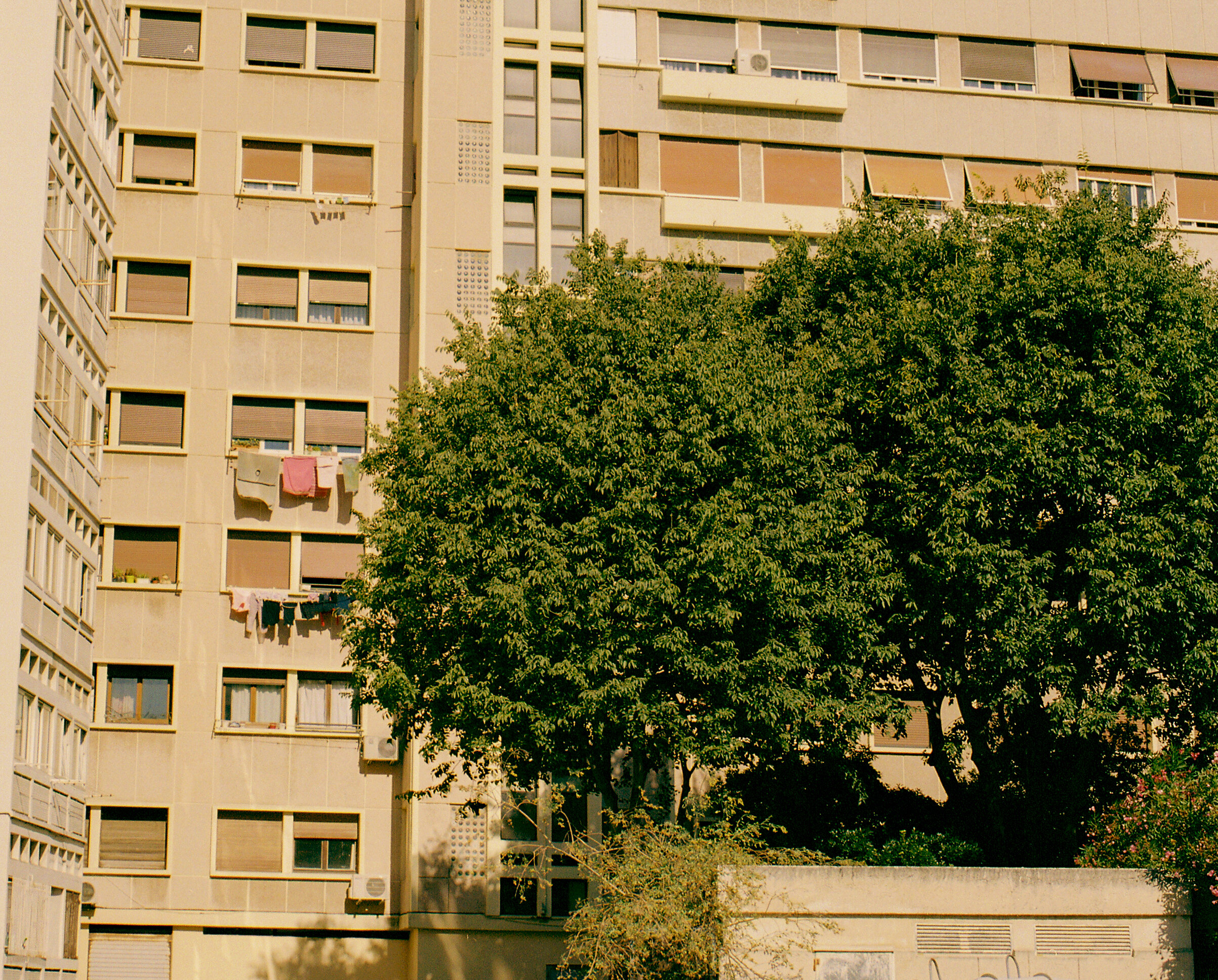

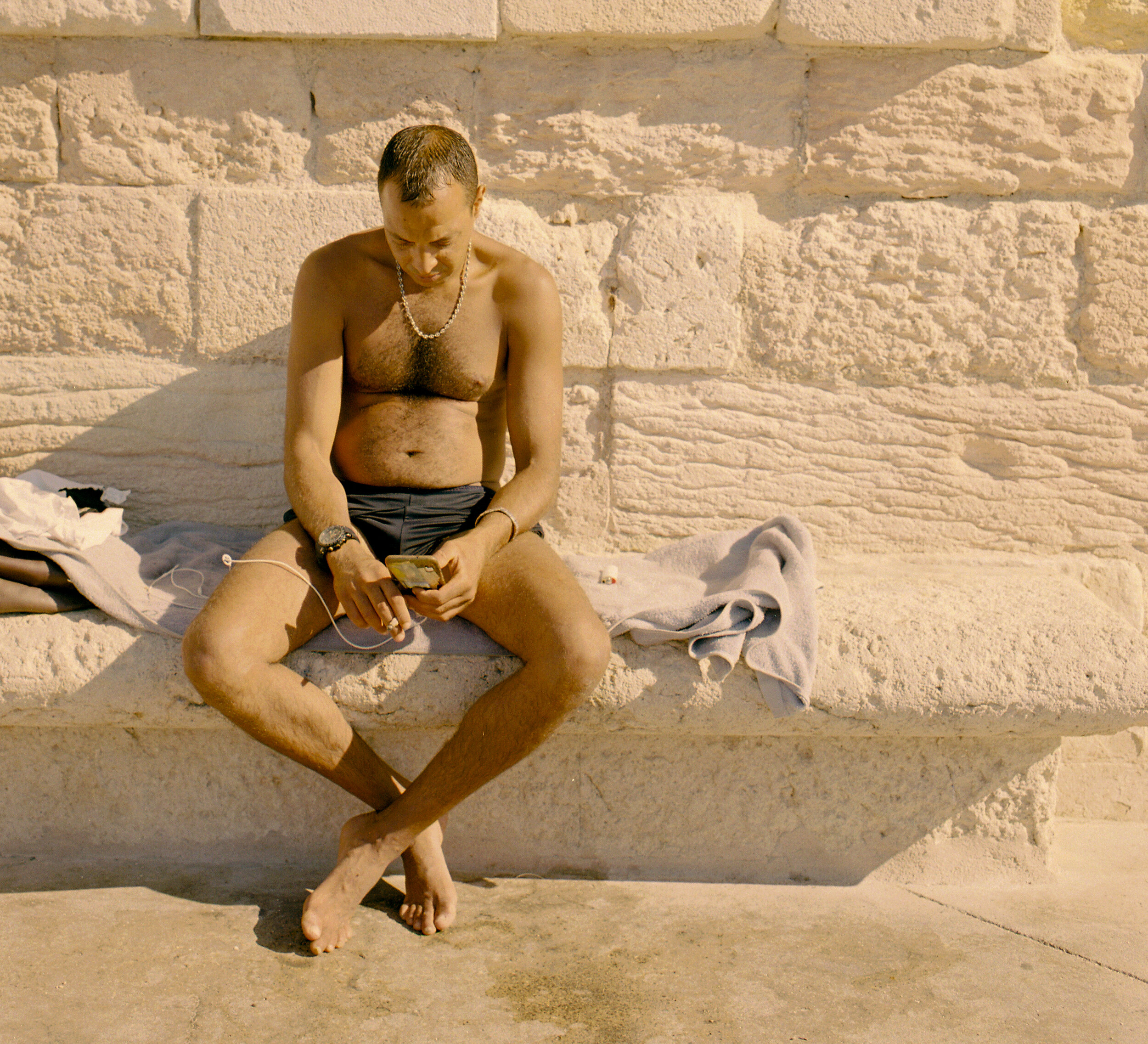
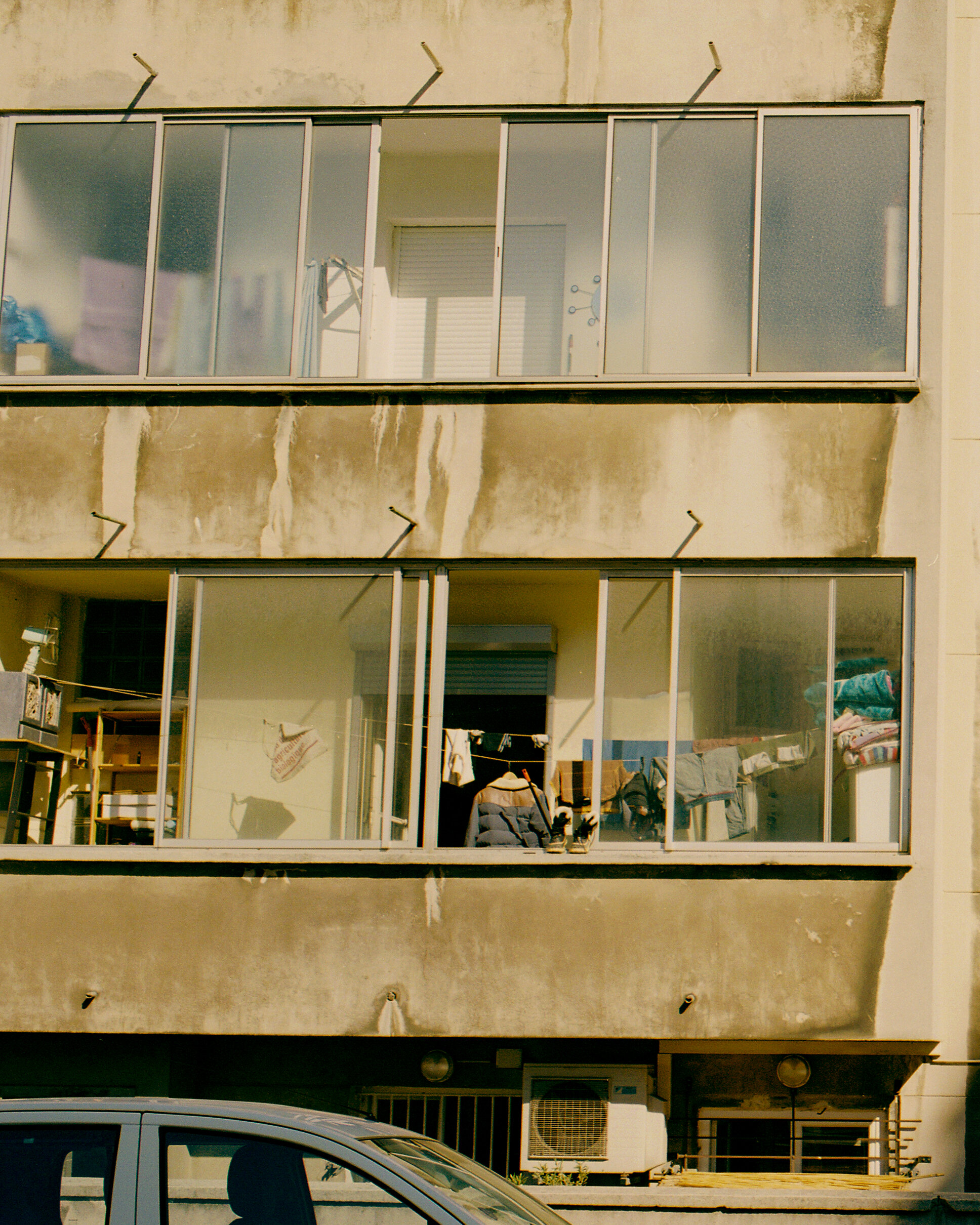
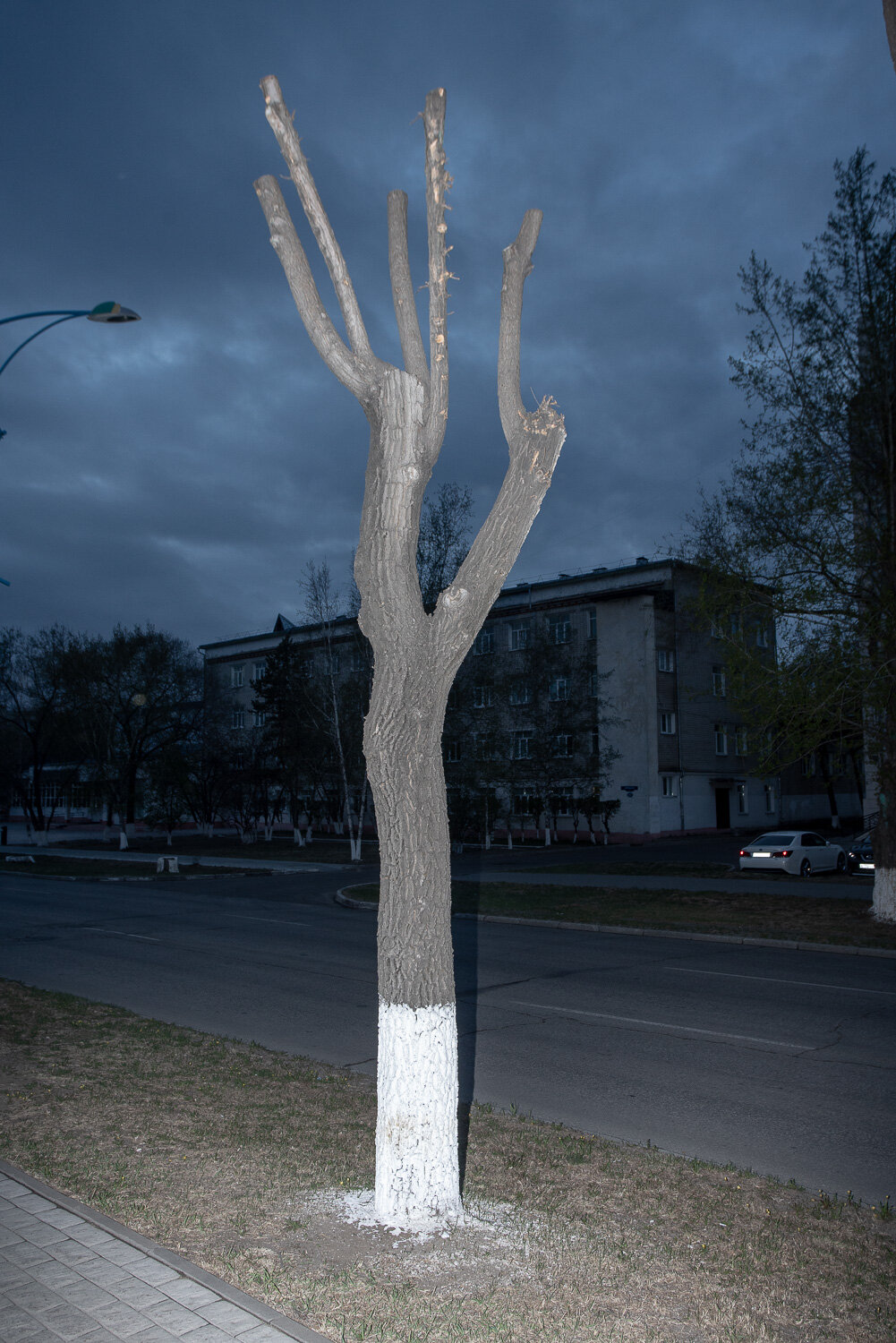
“I grew up in Soviet Russia. My peers and I had Soviet cartoons, cinema, football, skates, bicycles, but what we really wanted were games consoles and video recorders. Then the country in which I was born stopped existing. The space of the Soviet deficit was now replaced with the abundance of the capitalist world. The culture of East and West was seeping through, along with Snickers chocolate bars and Chinese Adidas fakes. Now, about 30 years later, video recorders and games consoles are packed into the smartphone. But I go to the shop and buy “Soviet” things. I dig them at flea markets, seek them inside the houses and in the garages of my friends. On the photographs, in the hands of young people – those who even did not live in the Soviet Union – these things turn into paradoxical objects. The objects that promise a brighter future that will never arrive.”

The process of removing a stone from its place of origin and relocating it to another area can be traced back to the earliest days of mankind. It may mark the beginning of plastic art and a first stubborn rebellion against a world that is hard and rough, indifferent and inaccessible like the the stone itself. It is not without reason that people turned against the stones with their resigned energies. They are the terrible other; an entire being without difference, without separation, a being, just like that, without any purpose. As such, it counteracts human freedom, which only begins precisely where life breaks down into a self and the world. Maybe the stone mirrors most clearly a longing for the dissolution of the fixed boundaries of the ego, for the loss of self, which is repressed into the unconscious. Survival in this sense means first and foremost self-preservation. Man repeats his own destiny with the stones: he wrests them away from their origin, breathes spirit into them, and gives them meaning.

By erecting the stones, an omniscient and ordering spirit that stands above all natural events becomes proverbially manifest. They are more than mere material, they are carriers of this strange and mysterious power, of a magic on which one's own life depends and in which it participates. With growing technical-rational control over the earth and its inhabitants, the human spirit increasingly recognized itself as this foreign power, and replaced magic with calculus. The stones that we encounter in the pictures are, if at all, perhaps still carriers of a profane prohibition. As a barrier they merely serve to prevent certain actions and as such escape our instrumental interest. The pictures of 'Menhir' are an attempt to revive the stones, to establish contact, start another dialogue about the reasons for the emergence of our modern culture and, finally, to revive ourselves.

Ruby Burgess’ To Who I Am is a personal photography project which visualizes a series of poems she has written over the past years. Her images, with an intimate and softened focus, depict the various emotions and experiences we go through in our lives. These emotions are brought to life through her lens as each scene acts as a kaleidoscope of her fragmented memories. As Burgess’ looks outward to visualize her experience, viewers are able to look inside of the photographer and observe the moments that have made her into who she is today.
- Alexa Fahlman






"Avalanche of Everyday Life" is a series depicts the spaces of a student centre under renovation. This student center was built in a national university in Taiwan. The centre is an old, complex modernist building which includes a cafeteria, student clubs, gathering halls, and two elegant staircases. In the last several decades, countless people have gathered, played and walked in the building- it was a common scene in their everyday life, until the renovation began. I tried to explore and photograph the centre through the period of demolition and reconstruction. The walls trembled with big noise, and the rocks of the floor fell onto the stairs like an avalanche. By shooting these images, I gradually understood that even if an avalanche happened in our everyday life, there is still something precious hiding within it. There is always light.

Do You Ever Feel Like Nobody Really Cares contains photographs taken in the United-States between 2013 et 2019 in the area of Fort Mill - a town of South Carolina located in the suburbs of Charlotte, NC - as well as drawings. Taking its name from a leaflet published by a local church, the book questions notions of loneliness, illusion and search for meaning by exploring the shapes of the urban landscape. The need to belong to a community occupies the physical space as well as the minds.
The project is coming out as a book in early December and is now available for pre-order. The book will be published by Club d'Histoire Locale, an independent publishing structure I founded in 2020 as an extension of my own practice and as a way to defend a certain idea of documentary photography.
While Chad Wong began Empty Spaces as a simple exercise to further explore the compositional aspects of photography, his project soon became layered with personal meaning. In turn, Wong’s initial focus on shadow and light functions to highlight the lingering effects aesthetics have on our associative cultural memory. In particular, he muses on the role Chinese-Canadian plazas play in East Asian diasporic identities, noticing how an patterned carpet, or green-chaired food court can trigger a collective, and cultural nostalgia. Here, we talk with Chad about the relationship between space and cultural identity, and how, despite a seeming emptiness, these spaces can still fill our hearts. Continue below for the full interview!
- Alexa Fahlman


What role would you say these Chinese-Canadian malls play in East Asian diasporic identities? Especially within Vancouver's cultural context?
C: In a practical sense I think it offers a space for alternative businesses that can only exist exclusively within the Chinese cultural context, think Chinese medicine apothecaries, classrooms for tutoring, a place that sells pirated DVDs and sometimes even a live fish market. But, at its core, I find that these spaces seek to provide comfort and familiarity to those who have immigrated here from Hong Kong and China. This of course can be seen through the architecture of these spaces. In many ways, Vancouver has a very distinct Chinese-diasporic culture in that it is spread out and sprawling across the city. To me it often feels as if there are two Chinatowns. In Richmond you will encounter Chinese-Canadian malls that are more influenced by the aesthetics seen in the late 90’s and early 2000’s architecture of Hong Kong. But as you travel towards Chinatown and East-Van you start to see places that are generally more influenced by an older generation of immigrants dating back to the goldrush. With that being said, you would be hard pressed to see anything remotely of semblance if you travel to Hong Kong now. It is as if through time it has evolved and created its own specific visual language that entirely belongs to Chinese-Canadian malls.
With that being said, on a more personal note, I believe that these malls play an integral role as a space that acts as a cultural connector between first and second generation Chinese-Canadians. Experiences that may seem abstract to my generation from the stories our parents tell us can be experienced in these places.


You mention on your website about bringing attention to the cultural cohabitation and the growing chasm between the English-speaking and the Chinese-speaking communities within Richmond. Could you speak more on this?
C: In 2018 myself and another emerging artist Crystal Ho were given the opportunity to undergo an apprenticeship with Evan Lee, an established artist from Vancouver to work on a public art project in Richmond. The theme of the project was centered around migration, among the many discussions, we eventually honed in on two major factors which contribute to the migrant experience and that was food and language. For me, someone who grew up in both Candian and Chinese culture I always felt that there existed an in-between status among second generation immigrants. In the end, my project took the form of a text-based piece that is reminiscent of the many menus seen in Hong Kong style cafes. The menu, rather than a typical translation between Chinese (in this case Cantonese) and English is instead transliterated. As such, it required someone who understood both languages to decipher this menu or two people who could only speak one of the languages to work together. Ultimately the goal was to encourage dialogue and conversation between those who may not often get a chance to communicate. As mentioned previously, Richmond is a unique place in North America in that one does not need to know English to live or even thrive. That is not to say that it is particularly a bad thing but I believe that this creates a cultural enclave that inadvertently alienates those who cannot speak Chinese, shutting down dialogue and perpetuates negative stereotypes from both sides.
While this current project does not directly address these issues, I feel that Chinese-Canadian malls provide a decent gateway for those not of Chinese descent to be able to share in our culture and collective memories.


At what point did your project turn into a much more personal reflection of nostalgia?
C: While this project began as a simple exercise on understanding lighting and shapes, as I continued with this exercise I found that I was subconsciously drawn towards photographing these semi-abandoned malls. I think at the time (and still) it gave me a lot of comfort to document these places, as if I am preserving a part of my childhood and adolescence. But more importantly, I think it was when the protests in Hong Kong for democracy were in full swing. It was difficult not being able to participate in the front lines and I felt the only way that I could release these feelings was to photograph these places that reminded me of Hong Kong. In a way it more or less signaled a beginning to an end to my personal relationship with the city, I remember traveling back in 2016 and realized all the places I used to frequent are no longer recognizable and that I could never go back (physically since the passing of the National Security Act and spiritually as the city continues to evolve). As a result, these malls felt more like Hong Kong than Hong Kong does to me and it is in many ways romantic to me. But perhaps these spaces only resonated with me and I began to question why; it all seemed so arbitrary, would someone who has never been inside a Chinese-Canadian mall have the same feelings when looking at these photos? I think that was when I started to question the notion of nostalgia in photographs and art; is it possible to communicate these very specific feelings through my documentation of these spaces?



Conceptually speaking, what is it about the everyday and mundane that strike you?
C: I think it is because the mundane is so invisible yet so impactful. It is always hiding yet present. You can walk by a place a thousand times and not bat an eye. It is only when you revisit the same place and suddenly all the feelings you never knew that were associated with that space comes rushing up. In that sense I feel that the mundane attacks our subconscious in such a way that it shapes who we are.



Reflecting on a deeper note, racist assaults towards Asian communities have evidently increased in North America due to Covid-19. How do you cope with what feels like such constant bad news? Has this at all affected your photographic practice?
C: It is definitely deeply concerning, certainly Vancouver has a checkered past in regards to racial discrimination against the Asian communities. While I am lucky not have encountered these acts first hand, I cannot help but remember when SARS in 2003 was in full swing and the discrimination I felt as a child. In many ways, that experience has taught me to be more wary and in general just act more defensively, which in the era of Covid has its benefits. For me the best way to cope is just to spend more time with family (within your bubble of course) and photograph more. In a way, I think Covid has somewhat made this project easier to continue as most places are in fact quite ‘empty’ so in that sense, it has been a small sliver of light.
I do have to point out that as these tensions grow, the cultural chasm we discussed earlier will continue to widen. And we have to be careful as Chinese-Canadians to not fall into similar prejudices as the CCP (Chinese Communist Party) funded news outlets aim to weaponize theses acts of discrimination against the Chinse population in North America to drum up blind nationalism.


Tell us about your creative process. How do you go about making images, from start to finish?
C: Comparing this project to my previous ones I feel that this may be the most challenging, I do not often work with representation in my work, even when working with photographs it is with the intent of abstraction and dissection that I go about constructing those pieces. With that being said, I find myself starting with a memory of the place, whether it be going to buy groceries with my mom or hanging out with friends getting bubble tea, I try to bring myself back to that day and access that memory. I typically shoot around 50 images in one area but only end up picking around 10. Generally I just walk around and look for good lighting, sometimes even just sitting and waiting for good lighting. The editing process is where everything comes to life, if photographing is documentation then editing is painting. This is where, to me, all the emotions begin to imbue itself into the images and where I can tell the story that I set out to tell


Lastly, I'm half Chinese myself, and one of my fondest memories is going to the Crystal Mall Food Court with my gong-gong and mom. You capture such a unique nostalgia that I, and I'm sure many others, can only really associate with a Chinese mall food court. I'm curious to hear your thoughts; how is it that such "empty spaces" also tend to be the ones that fill our hearts?
C: To me ‘empty’ refers to not just the physicality of the space but also spiritually, while some of these malls are in fact rather desolate, others are still thriving, but they feel empty. I think these ‘empty spaces’ fill our hearts in the same way hot soup fills our souls during the dead of winter. It is familiar but comes with a twinge of melancholy that brings us back to our childhood. When we come back to these ‘empty spaces’ we are also confronted with our own personal progress; what have we lost and what have we gained along this journey and in a way I think that brings a lot of comfort. But the most enchanting thing about these spaces for me is the fact that they are not SO empty, they are not entirely abandoned spaces. In fact you can still see a small but dedicated few who frequent them, whether bound by proximity or by loyalty, and I cannot help but wonder: ‘what are these people holding onto that I have left behind...abandoned?’ Perhaps the attempt of discovering the answer is what ‘fills my heart’. In that sense, it reminds me of Wong Kar Wai’s titular film Chungking Express; what stories do the middle aged woman, the kid working on his math homework, the ah-yi working at the wonton stall have to tell and how similar are our experiences?
“Loafer” is a collection of images I gather from walks and moments of meandering thoughts and feelings as well as portraits of time spent with loved ones. Mostly, the work is a love note to my walks and friends that I spend my time with.

Juliska, from the series Uniform © Kacey Jeffers
Culture. Fashion. Freedom. Nostalgia. Connection. Gratitude. These are just a few of the sentiments that come to Kacey Jeffers’ mind when thinking of his old school uniform–the gratitude, he jokes, stems from no longer having to impatiently iron his shirts on a Sunday night. On the small Caribbean island of Nevis, this Sunday ritual is a collective experience for many Nevisian school children, so much so that the weight of this memory is still felt by the photographer today. As he grew out of his uniform and into adulthood, Jeffers moved to New York to pursue photographic work. However, when his visa expired in 2018, he had to return home. Jeffers recalls, “I was in a state of fear: How would I survive? I had lived away from Nevis for 3 years and returning back was daunting.” Yet, amidst life’s uncertainty, Jeffers found clarity and opportunity in the clean salty air that greeted him upon landing back home. Following his return, Jeffers spent the next year stripping away his creative self, searching for purpose in this specific moment–it was then when the idea for his first monograph Uniform came to fruition. Working with the Nevisian cultural office and educational authorities to conceive the project, Jeffers set off on a tour of 14 different schools. His meditative portraits, comprising of 26 individuals nominated by each school, vividly depict the students’ individuality clothed behind their usual garb. Each photograph unearths a nostalgic gaze, a familiarity which in part derives from the fact that Jeffers was once one of these school children. However, Jeffers notes that there is something more to be recognized beyond the beauty. Here, his purpose is clear; Uniform speaks to “every Nevisian child and to all children of the African diaspora” to tell them that they can tell their own story–Uniform is their proof. Take a look below for our interview with Jeffers and a preview of Uniform which can be purchased here!
- Alexa Fahlman

Ado from the series Uniform © Kacey Jeffers

Alixandria from the series Uniform © Kacey Jeffers

Aniya from the series Uniform © Kacey Jeffers
How have you been coping with your day to day caught between a pandemic and political turmoil? Do you feel as though your creativity has been affected by the world's current circumstances?
K: I left New York in March. I was on the last flight out to Nevis, the next week our borders were closed. They are slated to reopen Oct 31st, so I’m free to travel. I had plans to return to Nevis to do a book launch and other events surrounding Uniform. But due to Covid, I left NY earlier with the knowing that these events would have to be postponed.
There’s a saying, “ When America sneezes, we (the islands) catch the flu” How appropriate is that?! Even though I am away from New York, and we’ve had few cases that have all recovered, I’m still feeling the sting. The combination of Covid-19 and the overflow of racial tensions is draining. I work on focusing my energy on what is of value in these moments: how can I channel my thoughts, feelings into meaningful and impactful projects?
When the pandemic set off, it was quite unnerving especially since a lot of opportunities got cancelled. I surrendered to the ‘it is what it is’ of the situation and quickly became very nimble. Once I’m able to understand the bigger picture–the ‘why’–I’m willing to strap in and roll on through.
I do believe things are always happening for me and not to me.

Antonio from the series Uniform © Kacey Jeffers

Apryll from the series Uniform © Kacey Jeffers

Aquila from the series Uniform © Kacey Jeffers
Could you tell us more about your childhood in Nevis? Are there any places, routines, sounds or smells that trigger your memories?
K: Part of my motivation for doing the book was to better understand who I was as a child, and to get a little bit closer to some concepts of childhood. Growing up I loved learning and reading. Walking through the halls of my old primary school brings back so many memories: feeling seen in grade 3, the first time I heard the word lingerie was in grade 4 on a spelling test ( I spelt it incorrectly! ), a classmate getting punished for using a calculator in grade 2, playing rounders (a game similar to baseball but instead of bats we use our hands) and so on. I’ve lived near to the beach my whole life, so the smell of the salty ocean air gives me a sense of home, hope even. As does food. Even in New York, smelling certain foods always triggers that sense of home.

Chassidy from the series Uniform © Kacey Jeffers

Dylan from the series Uniform © Kacey Jeffers

Jahlique from the series Uniform © Kacey Jeffers
What initially compelled you to return home to photograph Nevisian students?
K: I left New York for Nevis in 2018 because my work visa expired. I was in a state of fear: how would I survive? I had lived away from Nevis for 3 years and it was daunting ,that is, the concept of ‘going back’ to Nevis. As I was working my way through that fear, the uncertainty of my career (how would I continue? Do I even want to continue doing photography?) really forced me to think of my life on a deeper level and I gradually wanted to strip myself of the things that lay at my foundation as a human being that no longer served the highest version of myself. Day by day, I worked on chipping away a little piece of that. I started to think of who I wanted to be as a creative person, the stories I wanted to tell and my purpose. Eventually the idea for Uniform came to me. It felt like a project that only I could tell in this specific moment, one that felt true to me as an artist, and something that had the capacity to connect people from all walks of life. The idea of doing it really sustained me for the year I spent here, and now, taking Uniform to the next level motivates me even more!

Junice from the series Uniform © Kacey Jeffers
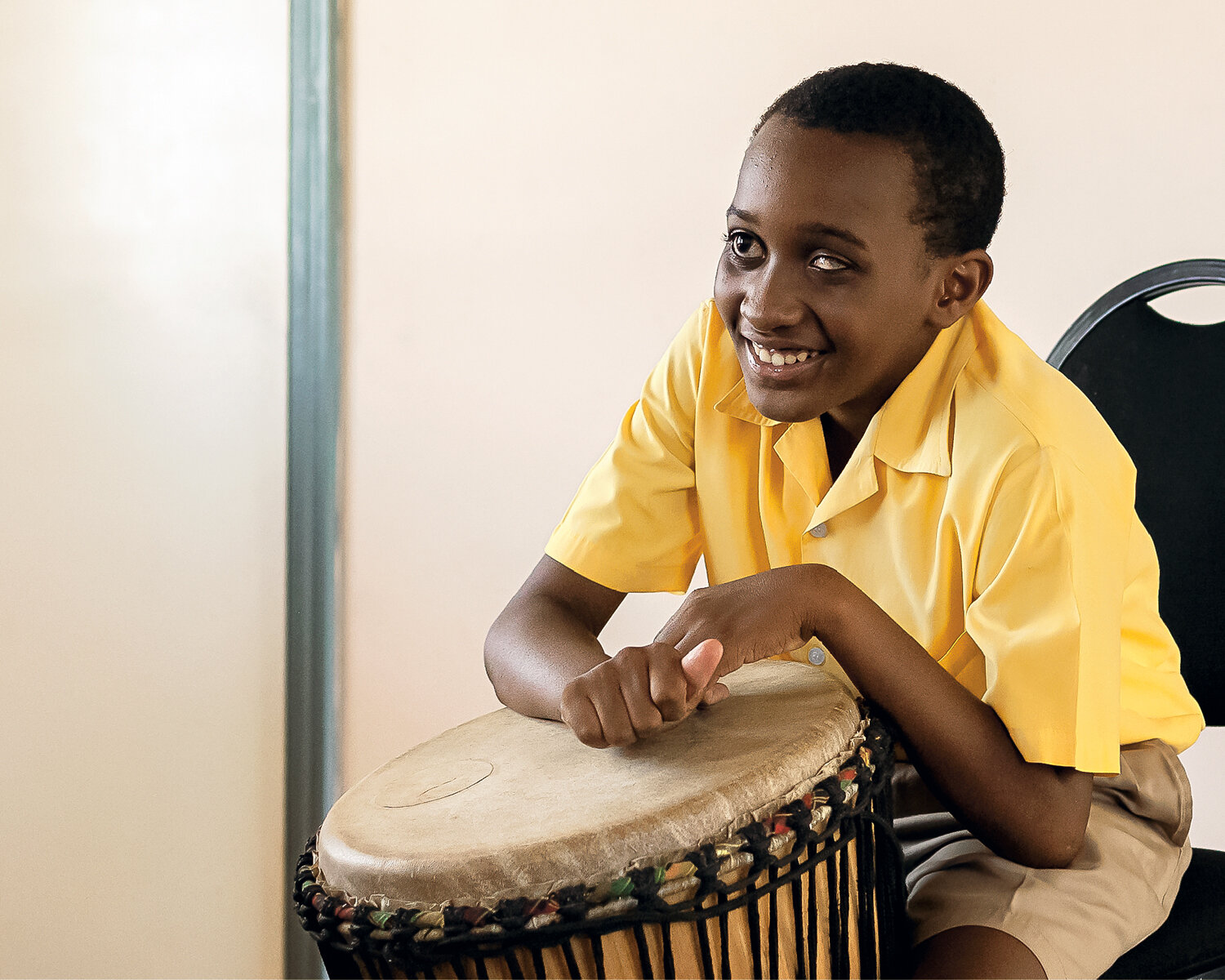
Kijaunte from the series Uniform © Kacey Jeffers

From the series Uniform © Kacey Jeffers
Could you take us through your creative process for "Uniform”?
K: I conceived the idea in October 2018 and I didn’t get the go ahead until May/June of 2019. From the get go it was meant to be a book. Through all that time, I felt into the project’s impact and how I wanted the project to feel. I met with the principals of the schools and told them about the project. I asked them to present students who were not always in the spotlight. It was exciting to go to the school and not know what the locations would be or who the students were (for the most part.) I loved walking into the situation blindly with only my internal sense of what the project would feel like to guide me. So over the course of two weeks towards the end of the 2019 school year, I went around the island to 14 schools and photographed kids whose ages ranged from 10 ( grade 5) to 18 (sixth form college.) I spent roughly 1 hour at each school doing the photographs as well as interviewing each student.

Roberto from the series Uniform © Kacey Jeffers

Shanelly from the series Uniform © Kacey Jeffers

Tejanah from the series Uniform © Kacey Jeffers
Your work represents a generation of Nevisian schoolchildren–all of whom are visually striking individuals. Can you speak more on the importance of representation? How might you have been affected by seeing a representation of yourself during your youth?
K: Now more than ever representation and visibility are important: who is in front of the lens and who is behind it. I always tell this story of going to school in the 90s: we would be outside playing and then a tourist would literally stop by and start taking pictures of us. We would run and hide. It was a common held belief that if tourists, who for a long time were synonymous with being white, took our picture we would end up in magazines naked, or worse. A lot of that couldn’t be disparaged especially when you would see magazines like National Geographic’s depiction of people who looked like us. Culturally, especially to a young child, that creates a disconnect. I ask the question, 'why not me?' a lot. Perhaps if I wasn't going through this famine of visibility and representation I wouldn’t be in the position to want to see that void filled.
I think what made this project special is that I am from here, and this story is as much mine as it is theirs. There is a familiarity, trust and authenticity that lives within, and evolves from that.
Every Nevisian child and children of the African diaspora, can tell their own story, Uniform is proof.

Zoe from the series Uniform © Kacey Jeffers

Thaine from the series Uniform © Kacey Jeffers

Tishaunte from the series Uniform © Kacey Jeffers
Louise Quignon’s series was taken in a nightclub that have been closed since the beginning of the lockdowns. Needless to say, the pandemic ravaged the live entertainment industries in cities around the world. These spaces designed to accommodate intense human activity have never reopened and remain frozen, uncertain.

For many children of first or second generation Chinese immigrants, “sik teng mm sik gong” or “pardon my Chinese”, is a familiar phrase which embodies the Cantonese diasporic experience. This in-between of identity– in which language and understanding clash and intersect– is at the heart of Gloria Wong’s photographic practice. Born and raised in Vancouver, Gloria is a curator, visual artist, and daughter of two immigrants to Canada from Hong Kong. Exploring the intimate themes of migration and family history, Gloria’s most recent work sik teng mm sik gong (pardon my Chinese) gives a voice to a cultural identity which many may have no language for, and speaks to the deep complexities and nuances of East Asian diasporic identities.
We talk with Gloria about her project while she sits in her makeshift “bedroom studio” in Vancouver. When covid-lockdowns started in March, Gloria explains her abrupt move from grad studio to bedroom closet; her prints and negatives are now scattered in every corner of her room. However, as sik teng mm sik gong realizes the detail in everyday mundane surfaces, one can’t help but imagine the beauty that could be noticed within Gloria’s lockdown clutter.
- Alexa Fahlman
Continue below for our interview with Gloria and her full series!
How have you been coping amidst the global turmoil and pandemic?
G: It’s been a strange season for sure. I graduated from Emily Carr just at the start of the pandemic so it’s been weird trying to navigate post-grad in the midst of all of this, I definitely feel like any creativity was “on hold” for a while and I’m just starting to get back into it now.
It’s been interesting to reconsider my work within this context though. Although most of my images are situated within household spaces, I found that being at home during the covid lockdown kind of stalled any impulses to photograph for me as the setting of home was kind of forced upon me rather than by choice.

Your photos show immaculate detail and care. In so many of your photographs–whether it’s the stillness of laundry hanging in the washroom, or the fresh pears wrapped in cushioning foam–you’re able to capture a collective, diasporic identity made entirely out of household effects. Could you speak more on the peculiarities of this?
G: Someone’s home is usually one of the most intimate places that you could photograph as every corner has the ability to reveal so many hidden details about a person and their life. Much of my diasporic experience has been mediated through the home and my relationship to my own family and so in trying to create photographs that could speak to a “Hong-Kong-Canadian” identity, I often found myself returning back to the domestic space as a site for that. The family home was often the one place for me where these two seemingly different, disparate cultures converged. A number of these photographs depict familiar, household effects situated in ways that I remember from my childhood, from my grandmother’s nylon socks that have been worn through to the hanging of laundry. In photographing these objects, I was aiming to find things that could speak to this “in-between” and the intersection of both of these identities rather than just one or the other. Although these items might seem ordinary or everyday, the different nuances in them speak to my complicated cultural identity.
Now more than ever, contemporary photographers seem to be drawn to documenting ordinary or mundane objects that seemed to resonate meaning, whatever their context may be. Do you think that this is becoming a new way of communicating? What is it about the mundane that draws us in so deeply?
G: I think that photographing the everyday has become a new way of connecting, not just for photographers but people in general. Documenting the everyday or mundane is something that has been very present from the very start of photography but it has probably been heightened even more so now with the current accessibility of the medium. Photographs of the most basic and ordinary aspects of our environments are shared so much online now too that it has made us realize how universal some of these objects and settings are despite maybe existing in different contexts.
I think the everyday holds a lot of possibility for image making as there is so much potential to imbue these seemingly insignificant objects with meaning. Some of my earliest influences were photographers like Stephen Shore and William Eggleston who were able to create incredible images out of very ordinary moments and places. There’s something really fascinating about how even the most generic objects can contain some measure of beauty worth photographing. It’ll be interesting to see if this interest in photographing the mundane continues after the pandemic or if staying at home or in quarantine has turned people’s interest away from the everyday and towards more dramatic or sensational scenes.

How has photography helped you navigate your cultural experience?
G: My images are, in a way, an attempt to create a sort of “family album” and archive that has been lost through the process of migration. Growing up, I often tried to dissociate myself as much as I could from anything that was related to Hong Kong and so in photographing these same things that I tried to distance myself from, I’ve been able to reconcile these two identities for myself. Photography also gives me a language to express my feelings around my identity that I’m not sure how to express through words, standing in for things that might feel unspeakable. The medium acts as a way for me to process my own experiences in the diaspora and find the different intersections of these two cultures. Making images of my own family and home has allowed me to create a space where I can be comfortable in the liminality and “in-between.”

Could you tell us more about your creative process?
G: My creative process is quite slow actually, I probably spend more time reading and researching than I do actually making an image. A lot of my research just starts with having conversations with people with similar backgrounds or experiences to my own, finding the similarities and differences between those. Using these conversation as a starting point, I’ll often read different essays or books that can fill in gaps and provide context to themes that I’m working with. I also spend a lot of time on my own looking at images by photographers working around topics of identity, family and migration. Although there aren’t that many artists exploring a specifically Hong Kong Canadian diasporic identity, I find that this type of research is important in helping me understand where my work is situated within contemporary photography.
While I usually have an imagine planned out in my mind before I take it, I also try and stay open to any ideas that emerge in the process of making it. The nature of the 4x5 camera and the very slow process of it also means that I spend a lot of time setting up for the shot, allowing for a comfortability to develop between myself and my subject.

To finish things off, do you have any upcoming projects we can keep an eye out for? Are you planning to stay based out of Vancouver for the next little while or will your future plans take you elsewhere?
G: Im hoping to expand sik teng mm sik gong (pardon my Chinese) outside of my immediate family and make it into a phonebook soon. I’m also planning on finishing a project in Hong Kong when it’s safe to do so as the rest of my family is in the process of immigrating over to Vancouver. I would love to be able to document the transitional nature of their spaces there during this as well as the places they are moving to here. Im also hoping to do my MFA at one point in the next few years, maybe in Europe, but I’ll be based out of Vancouver for the next little while at least!


Stuck in Canada during the height of the pandemic, Belgian photographer Annemiek Hofer spent months rediscovering her heritage through the vast scenery of the Albertan prairies. Her series Wild Rose documents her time of stasis and peace in a world which otherwise feels void of such calm. Continue below for some beautiful words by Hofer alongside her full series!
- Alexa Fahlman
These photographs were taken while I was stuck in Canada during the pandemic. I went at the beginning March and made it back to Belgium (where I live) in early May. I initially went to Canada to learn and document more about my heritage. My father was born into a Hutterite colony (a religious community) in Manitoba. I had taken time off and planned on staying for 3 weeks. Although my mom had warned me against going to Canada in March and the very long and boring drive to the Colony, I was very insistent about going that specific month. However, my plans quickly changed once I arrived. The colony where my father was born, is very strict and started having doubts about my arrival (they are against photography) and with the pandemic, things just made it so I couldn't go anymore. I was very disappointed to say the least, but I still felt grateful to be there; I hadn't been in Canada for 5 years.
My dad is nature fanatic and loves the mountains, but for some reason its beauty never seemed to resonate with me. For my birthday my dad decided to take me on a drive to a lake, which left me much more in awe with the drive than the actual lake. All of a sudden, everything just clicked. The fog and the vast emptiness of the land held so much beauty and sadness that it finally resonated with me. My flight got cancelled and the soonest I could book a flight was in May. Rather than feel down, I decided to take advantage of my situation. Almost every day we drove around the Albertan province. Those long drives made me feel like I was transported to a different era. Everything was so open and vast. It came across as empty, but it wasn’t. I felt a richness and heaviness; as if so much was buried deep into the soil, but never got the chance to thrive. So much of the land looked deserted, and there were so many traces of abandonment. I felt it represented the pursuit of my whole trip. The history I was hoping to learn more about, ended up being discovered in the land.
While the whole world was worried about the pandemic, I found solace in the Prairies. Some of the scenery was very apocalyptic with so many ghost towns and abandoned farming towns. I had never seen anything like it before. It felt like time could sit still for a while, and I could shuffle between present day and back to some strange old time where the worries of today had no place of being. Even though a lot of the scenery doesn't inspire beauty, I felt at peace, and to me there is nothing more beautiful than that.























Lubusz region of western Poland is one of the most neglected and unknown in the country. Being a border area for hundreds of years it moved between Poland and Germany and this complicated history left its marks in many aspects of life. Towns are laid on German architectural plans, people often use Germanised words and a majority from younger generation emigrated to the more prosperous economy next doors. Meanwhile, the culture and visual landscapes stay distinctly Polish - chaotic urban design, decaying social-modernist buildings, countless adverts, figures of Virgin Mary and an unexplainable kind of Slavic melancholy.
After the War a significant part of the population was resettled to Lubusz from nowadays Ukraine. People still seem to struggle to find themselves in a new reality and establish their identity. This could be both because of the resettlement and the fall of communism. Before, the region’s income depended mostly on state agricultural farms, which fell into ruin with the new political system. With no governmental support, industry or large cities the unemployment, alcohol abuse and emigration became parts of life.
Despite socio-economical situation, the atmosphere of Lubusz has a very specific charm of a border area, a forgotten in-between place, where the otherwise gone culture, of what reminds me of Poland from my childhood, is left almost undisrupted. Locals, who although may struggle economically, seem to live slowly and often enjoy their lives more than in the so apparent frantic race for money and career in large Polish cities.

We Came Here for the View is a collaborative project shot on one camera between photographers Tom Lyon and Pauline Vanden Neste. Set within the Aurore neighbourhood in Brussels, Belgium, their project explores former industrial zones as centres of immigration and transformation. The neighbourhood, developed in the sixties, is a succession of seven towers which have stood through several waves of the area’s immigration. Yet, like many industrial zones, the Aurore neighbourhood’s inevitable future lies in the hands of privatization and gentrification. In the mean time, however, life goes on, and it this passing of life which Lyon and Neste seek to capture; the banalities, solitudes and particular lives of Aurore residents such as Vivianne, Sami or Daniel. Continue below for the full series!
- Alexa Fahlman

In Chronicle I combine 1/2” and 1” square pieces cut from found photographs to examine the fragmentation of memories. When recalling our childhood, we may remember the shoes our father always wore or the way our mother held her hands: a part represents the whole. Photographs function in a similar manner. They do not show a whole person or an entire life, but instead capture a single moment. These keepsakes help determine some of the pieces of memory that stick with us.
This series started as an exploration of the overwhelming scope of humanity and human history and the insignificance of the individual. I wanted to find a visual representation of the approximately 6,393 deaths that occur every hour in the world. I made the piece Chronicle: Passing (6,393 Per Hour) to try to comprehend this staggering figure. I moved on to other subjects that are more about the nature of memory. The themes of death and loss are present throughout the series – most blatantly in the images of funerary flowers and disembodied shadows – as the source photos I use often have a built-in sense of history and sadness.
Gestures Detail
Grief
Locale
Mementos
Multitude
Passing
Setting

Harriet Moore is a fine art photographer based in London. Her series Takeaway is an ongoing exploration of the stagnating interiors of takeaway shops around London. Her photos, nostalgic and void of any human presence, contemplate the future of these family-run, often first-generation immigrant, takeaway shops. Takeaways, Moore writes, “are peculiar spaces that not many people see inside of anymore. Nowadays we tend to order food from an app or over the phone.” With the rise of delivery apps, the interiors of takeaway shops now evoke a bygone era, one in which we can briefly step back into, that is, if we decide to pick up our food in person. Continue below for Moore’s on-going collection!
- Alexa Fahlman





My memory is not particularly good.
A couple of years ago I received some rolls of film in the mail that I had left at my photo lab some time ago. Everything was as I expected, except for one roll of medium format film. I had absolutely no memory of taking one of the photos on that roll while the rest was totally familiar. The more I looked at the photo, the more I got lost. I couldn’t understand where or when it was taken. It didn’t look like anything I’d shot before. The image is out of focus and blurred in only one corner where a man seems to be walking towards the camera and a woman follows him. Their clothes recall the ’50s, and their faces are unclear. The place looks like the entrance of a mansion and reminded me of a post-funeral scene, or maybe a wedding. Even though I continued looking at the image for months, I couldn’t figure out where it came from.
I was at war with my memory. Photography had turned against me. My efforts at capturing the situation had turned inside out, leaving me with confusion and ambiguity. A moment of clearness gave way to skepticism. Once again, I started reflecting on why I photograph and on the scenes and subjects that I get immersed in.
I often find myself attracted to the in-between situations in the landscape of isolation and detachment in society. There is something that fascinates me about how we handle those moments of daily purgatory. I don’t usually photograph people but when I do, I find myself in some ways looking for their “ghosts”. This time, they seem to have found me.

Kyler Zeleny is a Canadian photographer and researcher based in Edmonton, Alberta. His most recent photobook, “Crown Ditch and the Prairie Castle” (The Velvet Cell, 2020), takes place over four years and travels across 15,000 km of North America’s prairie lands. As rural communities are being forced to grapple with uncertain futures clouded by mass urbanisation, the moments that Zeleny photographs offer a portrait of what he calls “a beast upon itself”; an understudied region where there is a unique meeting of landscape, industry, and most importantly, people who are a resilient breed created by generational lessons in fortitude and fortuned circumstance.
It’s late August when we first talk with Kyler about his project. He’s been travelling in between Alberta and British Columbia, and now, in the quiet of his parent’s farm, he sits on a stool in their garage, typing his thoughts on his laptop. Kyler tells us, “It’s a cool day on the prairies, overcast and cold, the mosquitos have gone but the wasps are still out in full force. I’m imagining an early Winter.”
Continue below for the full interview!
- Alexa Fahlman


You’ve published quite a few photo books, despite the increased digitization of culture, what is it about print that makes the process feel worthwhile?
The more we move to a digital world the more important physical objects become. I am keen on sharing my work through books and so I conceptualize my long-term projects early on as book projects, they could be shown in gallery spaces but for me, their primary resting place is in a book that can live on people’s shelves wherever they are.
The photobook is the medium that, more than others, allows us to express our ideas clearly, of course, we are bound by certain parameters within it, cost, size, etc. but we can decide sequence and intention. It also allows for a number of creative outputs than sending images into the ether of the web or placing them on location-based gallery walls for a short period of time. Because of this I think a lot of photographers are now embracing the medium of the photobook which is good and bad, good for the practice of photography bad for selling books as competition is tough.


Let's talk about your latest publication "Crown Ditch and the Prairie Castle", what was the initial inspiration for your project?
My first book—Out West (2014)—was about documenting towns smaller than 1,000 inhabitants in Western Canada (British Columbia, Alberta, Saskatchewan, and Manitoba). Out West focused only on the towns themselves and their aging structures and not the people or landscapes that make these communities what they are. So Crown Ditch & The Prairie Castle became the second chapter of a prairie trilogy where I looked at rural communities of 10,000 or less and only on the prairies. This project was really about trying to have a better understanding about who are the people calling the prairies home, what do they think, want and do. I’m not working on the third and final chapter that looks at my small-town comprehensively and uses community archives, found objects and my own photography to make an alternative history of a familiar place.


You mentioned that the Prairies is a particularly understudied region of North America, especially the Canadian Prairies – for those of the readers who are unfamiliar with this region, can you give a brief run-down of the area? If you could describe the Prairies in three words, what would they be?
We could go with ‘Big Sky Country’ or ‘Wide Open Space’
The trope of big sky as a psychological and spiritual boundary is a common feature when describing the prairie landscape. The prairies are home to the largest skies and the longest horizons. It is these two very simple elements that make the prairies what they are, a giant sky pressing down on an expanding and flat horizon. To some it will feel like an unfinished landscape and to others it will feel like beauty in the simplest terms.



With that being said, what was it about the Prairies that made you think "this is something I need to photograph"?
It's a vast region and yet there are very few photographers that are documenting it. My journey with photographing on the prairies began almost ten years ago and was a way for me to understand my home region. It has evolved from that to be about documenting a region that receives very little visual coverage. This is a problem for the prairies but is also a Canadian problem in general. It is an identity issue. We know what the American West is and the American South, but we have a hard time discussing what makes the Canadian prairies unique and different from other regions of North America.




For centuries, the Prairies were the domain of Indigenous peoples, did you feel that historical presence while travelling through the region?
That’s a tough but good question. Thomas King talks about the concept of the Dead Indian. For King, the Dead Indian is rarely actually dead but exists as a stereotypical Indigenous individual who conforms to well-worn Western stereotypes (war bonnets, beaded shits, etc.). The colonial-settler culture that exists on the prairies often thinks about indigenous individuals this way (as opposed to Living or Legal Indians that King also discusses) so their presence is sometimes felt or acknowledged but often in very coded and limited ways.
I think in a number of ways; rural folk share a closer relationship to the land than you would find in urban spaces. That is of course a generalization but exposure to open land and land-based industries suggest a stronger working understanding and an affinity to the land. I’m not sure if prairie dweller is overly cognizant of this and whether this is directly influenced by indigenous knowledge or culture.

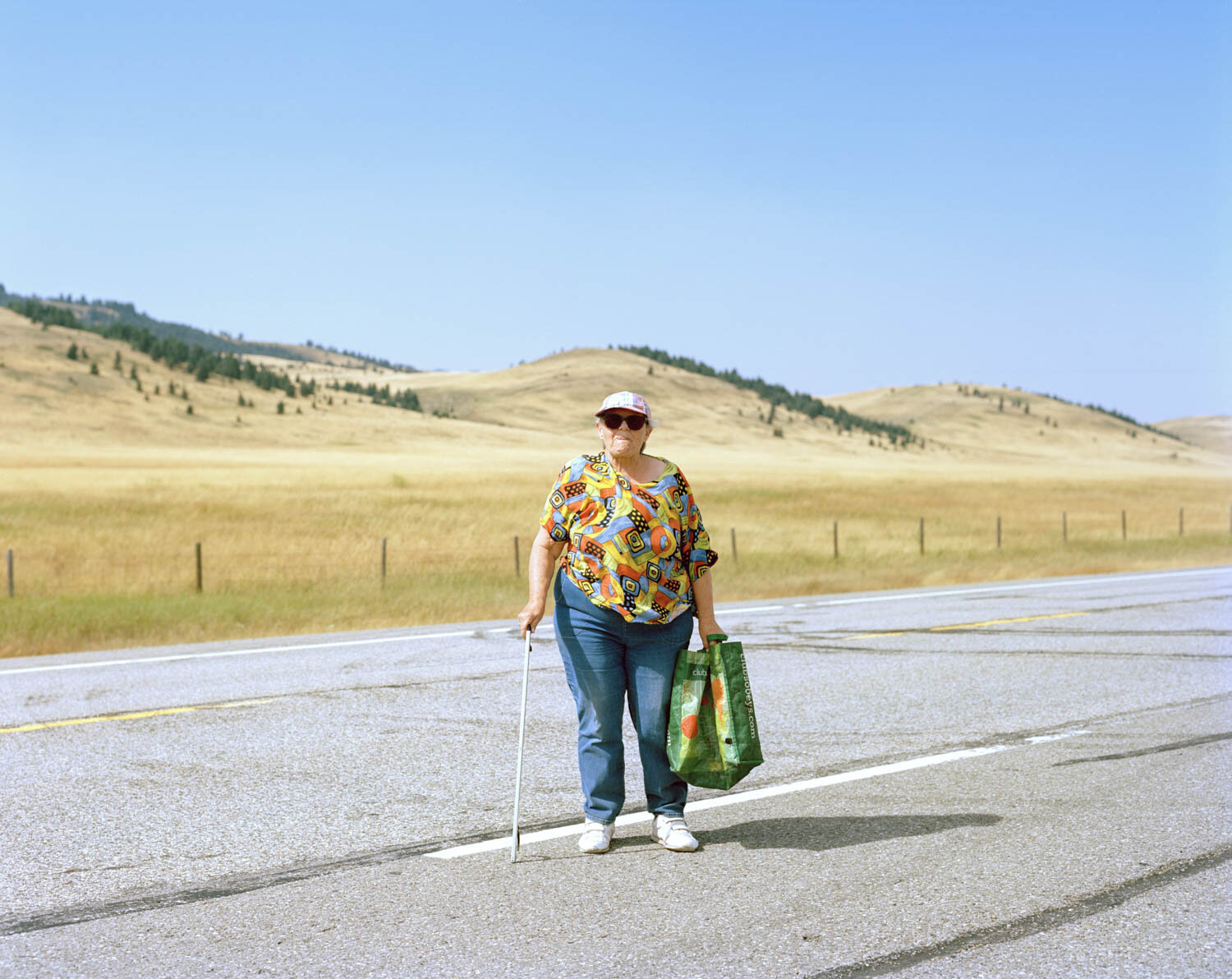

Have Indigenous cultures of the Prairies been preserved at all?
This is a question better suited for Indigenous experts, I have read a fair amount on the subject (one of my areas of teaching is Critical Canadian Studies), but I would still say I’m a far way from knowing the answer to that and other questions. There are some very knowledgeable Elders in indigenous communities that would hold this knowledge.
I can, however, speak about this from a photographic perspective. Historically, Indigenous populations have been photographed largely in stereotypical ways, often very false ways as discussed at length in The Imaginary Indian by Daniel Francis. There have been a few contemporary photographers who have photographed indigenous communities and individuals but no accounts of Indigenous photographers working on long-term projects that document their own communities on the Canadian Prairies. I myself have stayed away from photographing communities I feel I do not have the right or authority to capture and although I’ve included photos of Indigenous individuals in the book I’ve been highly aware of how and when they are being represented.


Did you have a favourite moment throughout your shooting for the project?
Not sure any one moment sticks out, it’s been a lot of work and every day being able to produce images on the region has felt like a privilege. Sadly, this is a region where very little happens and the status quo often dominates the culture of the region. There are a number of moments that definitely stick out, like the time a small-town business owner invited me in for beers and then let us stay at his house and cooked breakfast in the morning, or the countless occasions these folk shared their ideas and thoughts on how they live and the place they call home.
How has this experience shaped you both personally, and professionally as a photographer?
It has helped solidify my interest in recording the region. It has also helped me understand my home region and it has sustained me artistically by gifting me a topic I care very deeply about.



And to finish off, what are 5 things you think everyone should do if they visit the Prairies?
Love this question!
1. Visit a small town with a large and whimsical monument
2. Witness a prairie sunset
3. Chat up a local in a small-town bar
4. Go to Torrington to see the Gopher Diorama Museum (entry is only $2)
5. Drive to the West edge of the prairies, where the mountains meet the plains and flip-off the mountains


We’re bringing back photographer Carl van der Linde once again to feature his latest series Bagliore Solare. Shot in 2019 during a European summer, his photographs transport viewers to a world of pre-pandemic conditions–closeness, heat, and salt crystallized on the hairs of our skin. Van der Linde’s images were captured on 120mm and 35mm film during his extensive travels through the Mediterranean, covering Italy, Croatia and Montenegro. The title of his series translates from Italian to “Solar Flare”, a fitting title that epitomizes the extreme heat that so many can agree is synonymous with a true European summer. Carl’s photograph can be seen exclusively on the cover of SUITCASE Magazine’s Vol.31: The Freedom Issue.
Continue below for a written excerpt from Van der Linde’s travels, and his full series!
- Alexa Fahlman
"We were sitting on a regional train and just passed Santa Margherita Ligure. It was the summer of 2019 and we'd set out to explore the Mediterranean after a couple of weeks working and studying in bustling Milan. She was annoyed with me like on most of the train trips, staring out the window, gazing at the moving Italian landscape. I'd never before seen the Mediterranean, but have nonetheless chased blistering heat and crystal waters across the world. The train screeched to a halt at a small train station on the Italian Rivera. An older man was nodding off on the bench by the lavatory. Painted on the wall above him, written in cursive, I read "Stazione Zoagli". We were greeted by spiralling stone stairs that descended into the coastal town, around the corner from Rapallo. We dashed into different ally ways trying to find a restaurant, bar, cafe or any place we could put our bags down and have a drink. The towering Roman arch bridge cast a cooling shadow - a momentary relief from the sweltering sun. The overloaded backpacks were crushing and contributed to the tension between us. I had recently cut my hair into a bob with a fringe, which was a tremendous mistake seeing that the sweat almost permanently licked it to my forehead. Finally sitting down we had a cigarette, a coffee and a few glasses of prosecco - followed by a few more glasses of prosecco and Aperol spritz. She had a green and red scarf in her hair - she wore Italy well. Still not talking, she gazed out over the piazza while I was staring down the panting poodle at the neighbouring table. We settled the tab and with a bubbly buzz, we hoisted our bags onto our backs - hers first as I had to be the crane to get it over her shoulders. It's a miracle that my camera wasn't damaged during the trip as it proved bulk and clunky and was mostly flailing around in the tote strapped to my backpack. We set off once again down the road in search of a spot for us to get into the water.After a few more arguments, increasingly amplified by Italian inspired hand gestures, we saw Zoagli beach. It was strange that it wasn't a mirage. Sunseekers were flattened onto the rocks - their brown leather hides laid to dry on the pebbly Mediterranean landscape. We shed our bags and clothes. Like synchronised divers, we entered the ocean, finally feeling the healing Italian water. The salt crystallized on our hair and skin. Steam rose from the rocks where our wet feet touched. The hissing cicadas complimented the lapping of the water against the side of the pier. Out the water, we melted onto sun-hot stone, face first. I opened one eye, meeting hers. A solar flare emitted. Drawn curtains couldn't keep the sunlight out any longer."

Modern Cavalry photographs the cliché of one of the most visited beaches in Menorca: Playa de Caballería. Winking at the name given to the beach, the photographer plays with the meaning of the word cavalry, understood as a constituent weapon of an army made up of different bodies that roam the known land. For the photographer, the alienating bodies on the beach are part of a contemporary cavalry.
The artist immerses herself in the blinding light of summer, combining the bright and vivid colours of the Mediterranean with a distant and formal vision to search for the essence of the place and photograph its most current identity. With fine irony, this series of images hold up a mirror of modern society and reveal something about the people who pass through this place; their behaviour on the beach says something about the culture and traditions that a country supports. As Martin Parr says: "The beach is that rare public space where all the absurdities and strange national behaviours can be found."